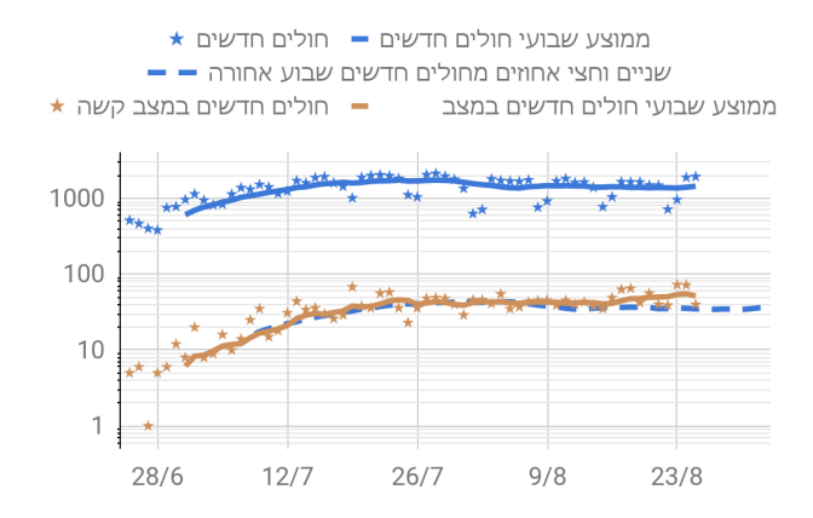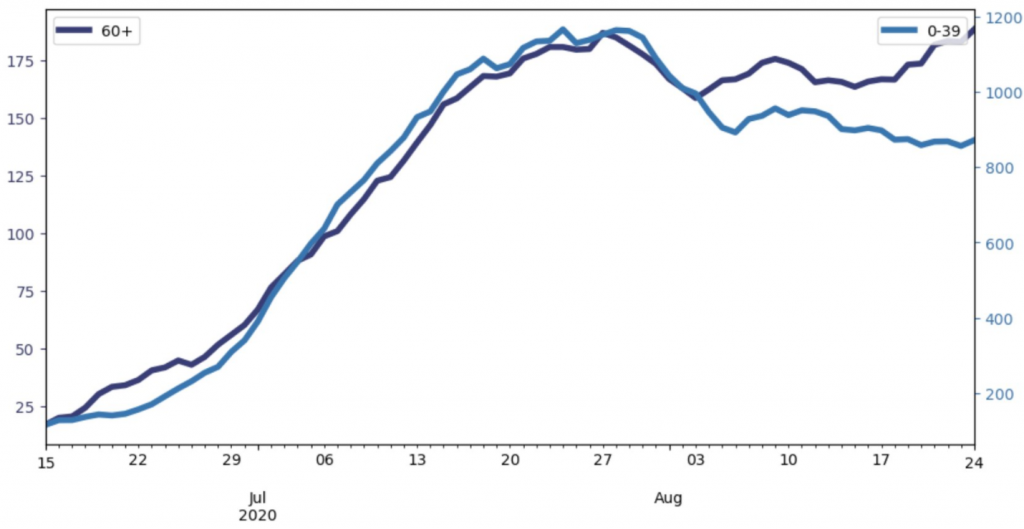In some sense, hospital numbers and deaths are the only ‘real’ measure of how a country is tackling the coronavirus pandemic. On that measure, things have taken a turn for the worse this week.
The drop in test positivity led me to predict that hospitalisations and serious cases would fall this week. In fact, the opposite has happened. Hospitalisations are up. Serious cases are up, too.
So what’s going on?
First, I wasn’t the only one to predict a decline in serious patients based on confirmed virus cases.

The Coronavirus Information Centre’s graph plots new cases (upper blue line) and predicts that 2.5% of them will become seriously ill. This prediction held up well since early July but has diverged this week. The graph above is exponential, so the small gap between the lines is a bigger miss than it looks. More people are getting seriously sick than we would expect. Eran Segal at the Weismann Institute also noted the seriously ill rising faster than his own predictions.
A higher percentage of cases are older people.
Throughout most of the second wave, the over-80s have been 1-2% of daily cases. That number has bumped up a bit to 3-4%, and the 60-79 group has also increased.

This graph from Eran Segel shows that until early August, the proportion of new cases that are over-60s and under-60s was basically stable, but that since early August, proportionally more over-60s are diagnosed with the virus every day.
If the cohort of new cases is older than in June and July, then that would mean proportionately more sick people as a share of the total caseload.
Hidden infections?
Eran has a further hypothesis: actually, let’s assume the breakdown of new infections is the same as in July. The decreased percentage of younger people would then be a result of fewer under-60s choosing to get tested. From the graph above, it would suggest about 300 cases a day that are being missed due to people choosing to not get tested.
Who chooses to not get tested? People who were exposed to a Covid case but don’t want to notify the Health Ministry and be forced into a 14-day home isolation. People with minor symptoms, perhaps, who don’t want to be blamed for sending their family, friends and colleagues into a 14-day home isolation. It’s frustrating, embarrassing to be the cause of such chaos; easy to stay home a week and tell yourself it was probably just a cold.
There’s also a communal aspect here. Haredim make up nearly 40% of all Israel’s virus cases, but that proportion was a lot higher until the last few weeks. Suddenly, Haredi towns have gone from virus hotspots to safe in just two weeks. Haredi schools have already reopened, too.
But the Health Ministry is concerned that Haredi communities are avoiding getting tested inside the official system. Some are rumoured to take private tests that don’t get reported to the government, while others may be avoiding tests altogether.
Nobody can completely confirm this theory, but the Haredi political parties have been heavily lobbying for more relaxations of the coronavirus rules, especially on synagogues. The community was very eager to ensure their schools and yeshivot opened last week without any closures or lockdowns. And they are threatening to bring down the government in opposition to the Gamzu Plan, because targeted lockdowns will disproportionately affect the infection hotspots, which in turn had been disproportionately Haredi.
So perhaps the drop in cases is because sick people are avoiding tests. Perhaps the fall in Haredi towns is because Haredi leaders are trying to massage the data to keep the synagogues and yeshivot open. Or perhaps it’s all a weird fluke in Health Ministry reporting cycles again and numbers will level out tomorrow (they’ve already dipped a little this evening).
The only thing we can say for sure is that things aren’t getting better in the hospitals right now. They’re getting worse.
2 thoughts to “Hospital numbers should be down; they’re up”
Comments are closed.